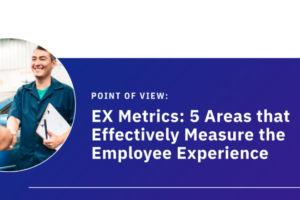Author: The InMoment Team
The companies that provide emotional, transformative brand experiences know that doing so is about much more than ensuring a superior customer experience (CX). CX initiatives are important, of course, but a great experience rides on a combination of marketplace, customer, and employee intelligence. It also comes from knowing that the employee experience (EX) is fundamental to and underlies customer experience. Today, I’m going to take you through how applying this understanding (and its toolsets) can help your brand become a world-class EX leader.
Why Start an Ex Program?
Most business evolutions start as “initiatives”, a trend we saw begin over a decade ago with customer experience. Fast forward 10 years, and we now see businesses that have leveraged processes, technology, and even organizational structure to become more customer-centric. Additionally, while concepts like employee engagement (EE), employee listening, and voice of employee (VoE) aren’t new, we’re beginning to see them used differently when it comes to prioritizing organizational resources or driving decisions, actions, and initiatives.
Employee experience programs benefit organizations in two major ways. First, they empower brands to create workplace cultures that attract, engage, and retain the best employees (the real difference makers in your company). This reduces costly recruitment, onboarding, absenteeism, training, and churn expenses. Second, EX programs allow brands to gather employee feedback critical to delivering a superior customer experience, which ultimately results in revenue and growth opportunities.
Though EX efforts are frequently considered distinct from CX ones, brands that optimize their experience improvement investments are adept at finding the point where the two intersect. Improve your employees’ experience, and you’re well on your way to improving your customers’.
Crawl, Walk, Run
Brands that are new to EX programs frequently communicate requirements and desired capabilities far beyond their actual capacity for employee intel. Thus, it’s important for brands to decide how and why they want to deploy feedback collection tools before they actually do so. Organizations must also establish how they plan to democratize and leverage employee learnings for decision-making and prioritizing action—failing to do so is a shortcut to losing both organizational advocacy and budget.
Driving demonstrable—and sustainable—experience improvement for both employees and customers requires carefully defining an X to solve for. Is employee churn a problem? Does your organization want to scale and need to recruit top talent in a competitive market? Whatever challenge your business is facing, take the time you need to clearly identify its every facet. You can then design an employee listening strategy, analytics plan, and communication strategy.
The Importance of Governance
Putting these initial program components in place is an excellent start, but companies also need to know how best to drive change if they want to create meaningful improvement. Like any other initiative, EX programs require executive sponsorship, frontline leader buy in, employee participation, and a cadence of accountability for driving changes.
EX program ownership must fall to more than HR if it’s to succeed—business unit leaders at various levels of the organization must frequently collaborate with their teams and each other to best execute on employee intel. This strategy also gives your entire organization a holistic view of the experiences it provides, which allows everyone to identify their roles and both upstream and downstream impact within improvement efforts.
The True Power of Employee Experience
Most organizational leaders sincerely believe that employees are the heart and soul of their business, their key differentiator, and their most valuable resource. However, if that’s the case, the question must be asked: why aren’t more brands EX powerhouses?
The answer to that question is what determines whether brands find EX success: the ability to drive real change. Organizations need to take action on the intelligence that voice of employee and employee engagement programs provide if they want to create a more meaningful brand experience. Many brands are content to watch metrics and just manage their employee experience rather than improve it, and therein lies the difference maker.
The idea of taking action is what everything in this discussion has been building up to. Gathering the right sponsors for your EX program helps ensure action. So too does getting employees involved. Creating quantifiable goals keeps programs on track, while sharing the intelligence that VoE and other EX tools uncover empowers teams to achieve heightened acquisition, customer and employee retention, an improved workplace culture, reduced operating expenses, and other important goals.
Realizing EX Success
When a company achieves EX success, everything changes. I’ve seen brands with a healthy EX culture exhibit strong, vibrant relationships between executives and employees. These companies create employee-focused policies and talent development opportunities that offer a brighter future for all. Suddenly, everything becomes a growth opportunity, not a risk. Employees feel appreciated and give that enthusiasm back at every turn.
All of this culminates in a meaningfully improved experience for employees, customers, and the business. In other words, brands that create a powerful EX culture for themselves will have found the moments that matter, translating into both an improved experience for everyone and a much stronger bottom line for the organization.
You can download the full PoV as a PDF by clicking the button below!



